Jun 6, 2016 | advice, coins, counterfeit, currency, education, grading
This is final part of a 6 part series
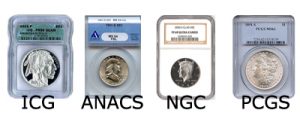 If you are uncomfortable trying to detect whether a coin is counterfeit or not, you might first consider buying from a reputable dealer who has return and/or buy back policies. If you buy raw coins and have questions, ask that the coin be examined by a third-party grading service such as Numismatic Guarantee Corporation, Professional Coin Grading Service, ANACSand Independent Coin Graders. These third-party grading services have a buy-back guarantee so that if the coin is ever found to be counterfeit after it was certified they will buy the coin from you at the price you paid. You may be asked to pay the grading fees. Some dealers may charge a service fee for submitting coins to the grading services on your behalf.
If you are uncomfortable trying to detect whether a coin is counterfeit or not, you might first consider buying from a reputable dealer who has return and/or buy back policies. If you buy raw coins and have questions, ask that the coin be examined by a third-party grading service such as Numismatic Guarantee Corporation, Professional Coin Grading Service, ANACSand Independent Coin Graders. These third-party grading services have a buy-back guarantee so that if the coin is ever found to be counterfeit after it was certified they will buy the coin from you at the price you paid. You may be asked to pay the grading fees. Some dealers may charge a service fee for submitting coins to the grading services on your behalf.
If you own coins that you may have questions about, either bring it to a dealer for an opinion or submit the coin to the third-party grading service yourself. NGC and PCGS have membership services that allow you to directly submit coins for authentication and grading. Members of the American Numismatic Association can register to directly submit coins to NGC. ANACS and ICG allows for collectors to directly submit coins for authentication and grading.

Sample of a PMG Holder

Sample of a PCGS Currency Holder
If you are buying through an online auction and you have any question about the coin, you are better off not trying to purchase it than trying to deal with returns. While there are quite a few reputable dealers who sell on these sites, it may take more than a month for the process from purchase to refund to occur. During that time, you will not have access to this money.
Remember, caveat emptor, “let the buyer beware.” Without a warranty or some type of assurance, such as a graded and encapsulated coin, the buyer takes all of the risk.
For sellers, caveat venditor, “let the seller beware.” Unless you expressly disclaim any responsibility, you will be held liable if the item is not true to its specification. You may also lose a future customer if that person feels cheated.
The Hobby Protection Act
Over the last number of years, we have seen when a hobby becomes popular and items increase in value, there are opportunists who will try to do whatever it takes to make money from the gullible and uneducated. This chapter was written to inform and educate you as to what to expect from those looking at your wallet and not to you as a valued customer so that you are not a victim.
When I discuss these issues I am eventually asked, “Aren’t we protected by the Hobby Protection Act?” In short, the answer is yes and no. The Hobby Protection Act of 1973 and was amended in 1988 represents an attempt at stopping counterfeits in all collectibles based on the way the world worked in 1973 and slightly updated in 1988. A lot has changed since then including the technologies available to counterfeiters.
The Hobby Protection Act requires that coins not made by the U.S. Mint include the word “COPY” somewhere on the surface. The law allowed law enforcement and buyers to go after the suppliers. The problem was that the suppliers were mainly in China and out of the reach of the U.S. criminal justice system. That changed in December 2014 when congress passed and the president signed the Collectible Coin Protection Act (Public Law No. 113-288). Under the new law, consumers and law enforcement can take civil action against the distributors and resellers of counterfeit coins.
The Federal Trade Commission has published draft rules to update the wa they enforce the (16 CFR Part 304) made by the passage of the Collectible Coin Protection Act.
FTC is required to publish the new rule in the Federal Register (81 FR 23219) and ask for public input on the new rules. These rules are the result of corrections made after a previous draft asked for comments on the costs, benefits, and overall impact of the rules.
Comments can be made on the FTC’s website or via postal mail as outlined on the website and in the Federal register.
Even though the law has changed, you should educate yourself and work with reputable people to build your collection. Education can be fun and the knowledge will help you better enjoy the hobby!
Credits
- Certified coins images courtesy of Dakota Coin.
- Image of the PMG holder courtesy of Paper Money Guarantee.
- Image of the PCGS Currency holder courtesy of PCGS Currency.
Feb 15, 2016 | grading, news, poll
In December, I coined a term “numismentos,” a portmanteau of numismatic + memento. I was reminded of that with the recent announcements from both major third-party grading services.
Professional Coin Grading Service announced that as part of their 30th Anniversary celebration that they created a series of labels for their slabs including a retro-green label similar to the first labels issued by PCGS 30 years ago. Some, like the Mark Twain “First Strike” label will only be available at shows like the recently held the Long Beach Expo.

The PCGS 30th anniversary label for silver (shown here) and gold 2016 First Strike American Eagles. (PCGS)

An example of a PCGS special First Strike insert label for the 2016 10th anniversary of the gold Buffalo coins.
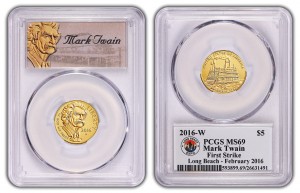
PCGS has produced special First Strike – Long Beach Expo labels for the new silver $1 and gold $5 (shown here) 2016 Mark Twain coins.
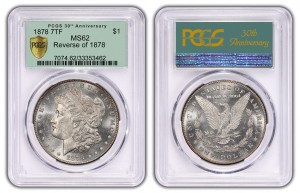
An example of the PCGS 30th anniversary retro 1986-era green label insert.
Numismatic Guarantee Corporation continues their signature labels march adding Former Perth Mint Director Ed Harbuz to the list of signatures that includes Elizabeth Jones and John Mercanti. Of course NGC as its other numismento labels.
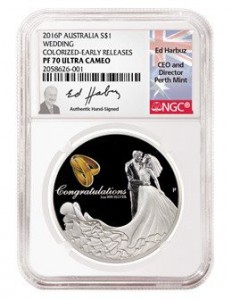
2016 Australia $1 Wedding silver proof coin with autograph label

Former Perth Mint Director Ed Harbuz
I was curious as to what my readers thought. Do you collect the labels? Do you look for the labels? Do you care? Take the survey and then weigh in with comments!

Loading ...
Dec 18, 2015 | commentary, grading, news, other
Exonumia are numismatic items that are items that represent money or something of value that is not considered legal tender coin or currency. When originally coined in 1960 by the founder of the Token and Medals Society (TAMS) Russell Rulau, the intent was to describe tokens, medals, and scrip. Over the course of time, other items have been added to exonumia category including some award medals and empherma like cancelled checks.
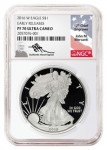
NGC John Mercanti Signature Label sample
Earlier this week, Numismatic Guaranty Corporation (NGC) announced that John Mercanti, the former 12th Chief Engraver of the U.S. Mint, has agreed to individually hand sign certification labels exclusively for NGC. Mercanti will autograph labels for coins bearing his design.
Last week, NGC announced that they struck a deal with Edmund C. Moy, the 38th Director of the U.S. Mint and currently the last full-time director, to autograph labels.
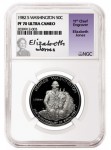
1982-S Washington Half with Elizabeth Jones Signature
In addition to signature labels, NGC has a primary brown label and lables for First Releases, Early Releases, Detailed Grade, 100 Greatest Modern Coins, Top 50 Most Popular Coins, and many others. Not to be outdone, the Professional Coin Grading Service (PCGS) has its own labels for First Strike, U.S. Marshals Service commemorative and 50th Anniversary Kennedy Half Dollar.
Even Independent Coin Graders (ICG) has been in the label business. Aside from their various label options, they also issued an autographed series as part of the 50 States Quarters program including the New York quarter designed by artist Daniel Carr that is part of my New York Hometown collection.
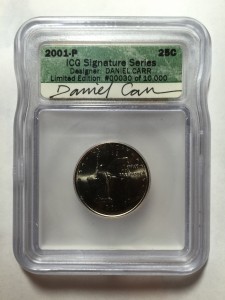
2001-P New York quarter with Daniel Carr’s autograph on ICG label
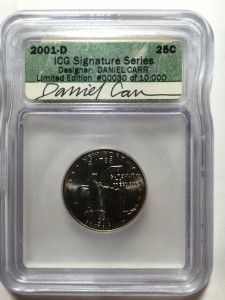
2001-D New York quarter with Daniel Carr’s autograph on ICG label
Autographs are not just limited to labels. Since becoming Treasurer of the United States, Rosie Rios has been a fixture at many numismatic events autographing Federal Reserve Notes that has her printed signature. Since Rios is a prolific signer, Rosie Dollars, as she as called them, are so common that her signed notes are not worth much more than face value.
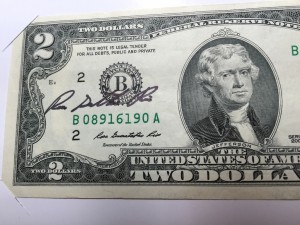
Series 2009 Federal Reserve Note autographed by Treasurer of the U.S. Rosa Gumataotao Rios
Collecting numismatic-related souvenirs are not just limited to autographs, which also appear in books. Collectibles include show programs, badges, buttons, ribbons, tags, and other souvenirs related to shows, clubs, and other collecting endeavors.
Autographed slabs, money, books, programs, and other items that are collected because they are numismatic-related but not real numismatic items can be fun collectibles. As an effort to me more inclusive with all aspects of collecting items related to numismatics, it needs a name. Marketing folks will tell you that a good name helps promote your product.
I have an idea. We can call these collectibles numismentos. Numismento is a portmanteau of numismatic + memento.
For example, let’s say you have a collection of programs from the World’s Fair of Money shows you have attended? That would be a numismento. Are you a collector of the labels from the third-party grading services or their sample slabs? You are collecting numismentos. Collecting nametags, buttons, or other items from shows? These are also numismentos!
Numismentos. Numismentos are collectibles that demonstrate the culture of numismatics but are not numismatic items.
Happy numismentos collecting!
NGC Signature Series Holder images courtesy of NGC.
Other images are the property of the author.
Oct 25, 2014 | coins, commentary, ethics, grading
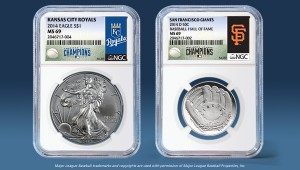 Fans of coins encased in plastic with special labels who also are baseball fans must be ecstatic that Fans of coins encased in plastic with special labels who also are baseball fans must be ecstatic that Numismatic Guarantee Corporation and Major League Baseball agreed to an exclusive deal that will allow NGC to reproduce team names, logos, and stadiums on labels used in NGC slabs.
Fans of coins encased in plastic with special labels who also are baseball fans must be ecstatic that Fans of coins encased in plastic with special labels who also are baseball fans must be ecstatic that Numismatic Guarantee Corporation and Major League Baseball agreed to an exclusive deal that will allow NGC to reproduce team names, logos, and stadiums on labels used in NGC slabs.
NGC announced that they will “encapsulate the National Baseball Hall of Fame commemoratives and other legal tender coins with attractive certification labels that feature a range of popular MLB trademarks.” Aside from the Major League Baseball logo, the logos of the 30 clubs, and stadium images, it will also include logos of All-Star Game and those used for post season.
NGC says this is gives their customers “an exciting new opportunity to combine their passions for the sport and the hobby.” What it gives is NGC a new area for marketing and to extract money from the market.
I understand that NGC is a business and has owners that are concerned about the business generating revenues. But what this will do is increase their revenues at the risk of some of the protections they claim is good for the hobby by encouraging cracking slabs, thus making the population reports even less reliable than they are today.
Let’s consider that I am one of those odd people that happens to collect the coin but it happens to be in a slab to ensure that it is genuine and the grade is something agreeable. This is a really nice coin and it fits in with my collection. But the coin happens to be in a slab with the logo of the New York Yankees. I hate the Yankees. I despise the Yankees. I have hated the Yankees ever since my father, the Brooklyn Dodgers fan, taught me to say “Let’s Go Mets!”
Unlike the fans of plastic, I really consider the coin encased in the slab. It is possible that I may like a coin even with the consequence that the label inside that slab has a decoration I am allergic to. If I decide that the coin is worth purchasing even if I ignore the label, I will buy the coin, but that label will have to go. There is no question that when I bring the coin home, the slab will be cracked, the coin removed, and the label finding its way to an appropriate disposal fitting of my opinion of that team.
Once cracked out of the slab, I could send it back to NGC and just have them re-grade the coin an put it in a plain slab. I could send it to Professional Coin Grading Service to see if they will give me a more solid grade. If it is a Morgan dollar I can ask ANACS to attribute the VAM. I could also ust keep it as a raw coin. Since the vast majority of my collection is not slabbed, this is not a problem. Besides, I know it is genuine because NGC slabbed it and I could submit it later if I need it slabbed again for resale.
Frankly, how many people actually save the labels and report their crack outs to the grading services? In the few cases when I have cracked coins out of its plastic tomb, I have not reported the cracked out coin to NGC. They have been cracked out of the slabs from multiple companies and submitted to NGC at a time I was working on a registry set. I believe this will encourage cracking out of the slab and make the population reports less reliable than they are today.
Not only will this affect the grading service population reports but it could affect coins with Certified Acceptance Corporation stickers. My hatred of the Yankees will not have me think twice about cracking that plastic just because the CAC or anyone else put a sticker on the slab. If I am not telling NGC I obliterated their label, I am not reporting it to CAC either—especially since I am not exactly a fan of CAC.
I do not begrudge NGC for doing what they need to do to earn a living. But they need to explain how these gimmicks align with their uncompromising standards and a commitment to integrity. Just admit that these gimmicks are being used to improve revenues and that everything else is window dressing. I would respect the honesty.
Image courtesy of NGC.
Jul 14, 2014 | coins, fun, grading
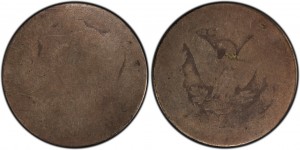
This 1878 eight tail feathers Morgan dollar, graded PCGS PO-1 (none worse!), is from the End of the Trail VIII Collection of Low Ball Morgan dollars that will be exhibited for the first time during the 2014 ANA World’s Fair of Money.
In 2009, PCGS began to offer rewards for what they called and “everyman” or second tier registry competition. Apparently, it became a race to the bottom. While people are looking for the best coins their money can buy, someone went quite the opposite and set out to find the worst of the worst.
“It is the all-time finest, or in this case, the worst-of-the-worst basic Morgan dollar set in the Low Ball category. While collectors have a lot of fun with the Low Ball sets, remember that it often is just as difficult and exciting to build a low grade set as it is to assemble a high grade collection,” said PCGS President Don Willis.
Who am I to argue. After all, someone put together a set of PO-1 and FR-2 coins, many marked “None Worse,” and probably cost more to have them graded than the coins cost to purchase. Then who is to say that some did not find their way into a pocket or two before being submitted?
Cynicism aside, there is something ironic about putting together a set like this and it has to do with just having fun. It had to be a lot of fun to go around and search through junk boxes or ask dealers for their worst coins. It must have been interesting seeing the face of some of the dealers when they hand over their worst Morgan dollars only to be told they were not bad enough.
Think about it for a moment. Dealers are looking for the best, most pristine inventory to sell to eager buyers who walk by their cases looking at the pretty and shiny coins. When coins are not good enough to make the inventory, they are thrown into junk boxes for people to pick through. Larger coins, like Morgan dollars, would be sold for a price around their melt value since there would not be much of a numismatic premium.
The adventure had to be a lot of fun for the person assembling the set.
That what this is all about, having fun! If you are stressing out about the worth of your set, are you really having fun? Are you having fun worrying about the plastic entombing the coin or whether someone placed a sticker on that plastic or is the coin the most important part of your collection?
I know the registry sets exist for the third-party grading services to promote their products and get people to submit coins. I know putting together a top set can be gratifying. But is it fun? Are you putting together that set for the fun or the profit?
There are a lot of people who collect coins in some form. Some collect high grade Morgan dollars while others collect varieties or VAMs. Some pursue the best and most rare coins while you find many digging through junk boxes at the shows looking for that one small gem to fill the hole in their collection. You may like high-grade Buffalo nickels while others are searching half-dollar rolls they pick up at their local bank.
Regardless of how you collect, what you collect, and where you find your collection, if you are not having fun then maybe you should rethink what you are doing.
Just for kicks, here are three of my “low ball” coins:

This 1794 Liberty Cap Head Right Large Cent has been around since the time of George Washington and looks the part. This coin has been cleaned making it a candidate for a no-grade if I should submit it to a grading service.
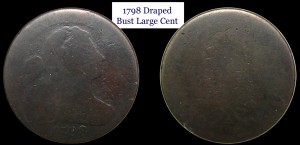
A very worn flat 1798 Draped Bust Large Cent. It took a lot of light and a 16x loupe to determine the date!
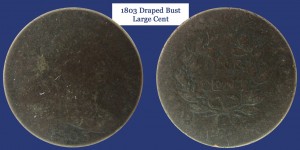
Another worn flat Draped Bust Large Cent. This one is from 1803 and just has a lot of character.
Now if you would excuse me, there are some tokens and medals from my hometown of New York I bought at the Whitman show I need to add to my collection.
Morgan dollar image courtesy of PCGS.
Jan 11, 2013 | awards, coins, dollar, grading, Peace, rareties, silver, US Mint
Now that it is award season, Professional Coin Grading Service is getting into the act by release its first annual listing of the “PCGS Top 100 Modern United States Coins.” PCGS is using the rising popularity of modern coins, those minted since the change to base metals in 1965, to bring this list to the public. PCGS announced the list on January 11, 2013, during a luncheon at the Florida United Numismatics Convention in Orlando, Florida.

PCGS is offering a $10,000 reward to verify a genuine 1964-D Peace dollar, the number one coin on the new PCGS Top 100 Modern U.S. Coins list. This image is a PCGS artist’s conception of a 1964-D Peace dollar.
“Mint records indicate that 316,076 1964-dated silver Peace dollars were struck at the Denver Mint in May 1965,” said Don Willis , President of PCGS, “but they were all were supposed to be destroyed.”
PCGS believes that not every 1964-D Peace dollar was destroyed and has offered a $10,000 reward “just to view in person and verify a genuine 1964-D Peace dollar.”
In 1964 the price of silver rose to new heights that it made the value of ordinary circulating coins worth more for their metals than their face value. Because of this, silver coins were being hoarded by the public and becoming scarce in circulation. Western states that relied on hard currency including the gaming areas of Nevada needed the U.S. Mint to strike additional coins for circulation.
The striking of a dollar coin had a powerful ally: Senator Majority Leader Mike Mansfield, Democrat from Montana, whose state would be directly affected by the new coins. Although the numismatic press was not in favor of the measure because of its limited ability to solve the coin shortage, Mansfield pushed a bill through congress to authorize the Mint to strike 45 million silver dollars.
After much discussion, the Mint looked for working dies but found that few survived a 1937 destruction order. Those that did survive were in poor condition. Mint Assistant Engraver Frank Gasparro, who would later become the Mint’s 10th Chief Engraver, was authorized to create new dies of the Peace dollar with the “D” mintmark. Since the coins would mostly circulate in the west it was logical to strike them closest to the area of interest.
Treasury Secretary C. Douglas Dillon was opposed to the the coin and wrote a letter to President Lyndon B. Johnson saying that the coins would not be likely to circulate and be hoarded. After Dillon resigned, Mansfield questioned the new Secretary, Henry H. Fowler, who assured Mansfield that the coins would be struck.
Although Mint Director Eva Adams, who was from Nevada, also objected to striking the coin, the Denver Mint began trial strikes of the Peace dollar on May 12, 1965.
When the coins were announced three days later, coin dealers immediately offered $7.50 per coin which would ensure that they would not circulate as intended. Everyone saw this as a poor use of Mint resources during a time of sever coin shortages. Adams announced that the pieces were trial strikes never intended for circulation and were later melted under reportedly heavy security.
To prevent this from happening again, Congress added a provision in the Coinage Act of 1965 (Public Law No. 89-81; 79 Stat. 254) that put a moratorium on striking silver dollars for five years.
There have been reports that some Peace dollars were struck using base metals (copper-nickel clad) as experimental pieces in 1970 in anticipation of the approval of the Eisenhower dollar. The same reports also presume these coins have been destroyed.
“It sometimes takes years for famous coins to surface,” said Hall. “Until 1920, no one knew there actually were 1913 Liberty Head nickels in existence. Until 1962, no one knew the 1804 Draped Bust silver dollar and the other coins in the special presentation set given by the United States to the King of Siam in 1836 were still in existence.”
“When we offered a $10,000 reward in 2003 to be the first to see and authenticate the long-missing Walton specimen 1913 Liberty Head nickel it resulted in the re-discovery of that coin after a 41-year absence from the hobby,” Hall continued. “Perhaps this new reward offer will help solve the mystery of whether any 1964-D Peace dollars survived the melting pots. It’s the number one modern U.S. coin.”
For collectors of silver crown-sized coins and large U.S. dollars, the 1964-D Peace dollar is the ultimate fantasy coin. As someone who collects silver coins including modern bullion issues, it should come as no surprise that I chose the 1964-D Peace dollar for this blog’s logo. My version was made using Photoshop and colored to not look “real” to avoid potential issues from our law enforcement friends at the Department of the Treasury.
It would be difficult to put a price if a version of the coin is found. It would certainly be a unique coin whose auction would start well out of my price range—maybe set a record for being the highest price paid for a single coin, topping the 1933 Farouk-Fenton Saint-Gaudens Double Eagle that sold for $7,590,020 in 2002.
As part of the announcement, PCGS announced the top five in the PCGS Top 100 Modern U.S. Coins as follows:
- 1964-D Peace Dollar: The most controversial and one of the most famous of all modern issues.
- 1975 proof no “S” mintmark Roosevelt dime: Only two known, and one recently sold at auction for $350,000.
- 1974 aluminum Lincoln cent: 1,570,000 were minted but only one is known and is graded PCGS MS62.
- 1976 proof no “S” mintmark Bicentennial Type 2 Eisenhower dollar: only one example is known.
- 2000-W proof Sacagawea dollar struck in 22 carat gold: 12 are known
1964-D Peace dollar image courtesy of PCGS.
Oct 28, 2012 | coins, gold, grading
Professional Coin Grading Service announced that they certified their 25 Millionth coin. The coin is a rare 1871 (Meiji 4) 10 Yen With Border on the Reverse variety. It was among a group of 33 coins recently submitted by a PCGS Collectors Club member in Toyko. On October 24, 2012 it was certified PCGS Secure Plus™ MS65.
As a gift of appreciation to mark the milestone submission, PCGS is awarding the Japanese collector a Saint-Gaudens Double Eagle gold coin graded PCGS Secure Plus MS65 and valued today at $2,500.
The 1871 10 Yen is an important coin in Japanese numismatic history, according to PCGS. During the fourth year of the reign of Emperor Meiji, Japan adopted a gold standard under the New Currency Act of 1871, and it marked the start of the modern era of Japanese decimal coinage.
The 1871 10 Yen contains 16.6 grams of .900 fine gold, and 1,867,032 of the coins were minted that first year. The obverse design features a dragon and a pearl representing the sun. The reverse includes a mirror, sunburst and military banners with a raised line border around some of the design elements.
PCGS estimates the value of this particular coin at $6,000 or more.
Congratulations to PCGS on this milestone!
Image courtesy of PCGS.
Sep 12, 2012 | coins, dollar, grading
Numismatic Guarantee Corporation will go retro with a limited edition 25th Anniversary Holder to celebrate “25 years and 25 million coins.”
The announcement made on September 11, 2012 said that NGC will offer the Limited Edition holder with a black core and special label for Silver Eagles, Sacagawea, and Presidential Dollars for coins submitted between October 1 and December 31, while supplies last. Coins submitted for retro holders must be submitted at the Modern Special tier or higher ($20 per coin, five coin minimum) with no extra fee for special holder. Invoice must be marked “RETRO HOLDER” and no cross-overs allowed. Please read NGC’s announcement for more information.
NGC was founded in 1987, by John Albanese after co-founding Professional Coin Grading Service. For their first month, NGC encased coins they graded in a holder with a black core (see image to the left). The black core was only used for about a month before NGC switched to the white core we know today. Because coin grading was very conservative in 1987 as compared with today, it was common for the coins in the black holders to be cracked and the coins resubmitted in hopes to have the coin grade higher. As a result, fewer coins have survived in those black holders making the holder a collectable unto itself.
This is an interesting gimmick by NGC. Not only have they found another way to get around the “buy the coin, not the holder” sentiment, but without announcing how many holders they will release, could be fueling speculation on the value of the holder as a premium over the coin. No doubt it will add to the continuing discussion as to collectibility of special holders and labels from the third-party grading services.
Aug 21, 2012 | grading, review, technology
Just before the World’s Fair of Money, Numismatic Guarantee Corporation announced a new app, NGC Coin Details for both the iPhone and Android devices. The free app, which can be downloaded from the AppStore for the iPhone and Google Play for Android, provides verification of the certification of any NGC graded coin either by scanning the barcode or entering the serial number.
In addition to the verification service, the app provides coin details, images if they are available, pricing information, description and analysis, and upcoming auction information if it exists. The app is consistent with the look and feel of NGC’s website and provides most of the information they claim.
This review is based on the app for the iPhone but was told that the Android version is similar in look and feel. If someone wants to contribute a review of the Android version of the app including screenshots, please contact me to make the arrangements.
Testing of this app was performed at the World’s Fair of Money but only one set of images were taken while scanning “cheap slabs.” Some dealers became upset with my taking out the phone and pointing it at the coin. I then began to ask dealers if I could try out the app without a lot of success. One dealer accused me of attempting to create a diversion to steal his coins even after I asked for permission, offered my business card, and showed him the NGC app. Although I did not ask, these images were taken at the table for Wayne Herndon Rare Coins with Wayne sitting nearby. I did not want to disturb Wayne since it looked like he was making a nice sale—he deserves my hearty THANKS!
The app opens with a quickly disappearing splash screen and then a page that asks to click on the plus butting to verify a new coin. I do not know why it does not go directly into the verification process, but it does let the user know that if they want to verify a new coin where to go. It then brings up a screen that allows the entering of a certification number from the label or allows the scanning of a barcode.
Barcode scanning is a very nice feature when it works. However, with this app, I found that whether it works depends on the age of the label. New or newer labels that I believe were created since around 2007 can be read by the app. While these may be the most prevalent labels found, it is fortunate that NGC serial numbers are short and they bring up a digital keypad for data entry. Using a keypad-only interface is very helpful in those circumstances.
Several coins I tried had complete information including most Morgan and Peace Dollars, Buffalo Nickels, and current series pre- and post-1964 striking. It was very easy to use, especially for coins whose barcodes were scannable by the app. Where the app was not as good were for coins in older slabs whose barcodes could not be scanned. For those coins, there were missing detail information including some variety information that was found when scanning a similar coin in a newer slab. This was interesting to see the difference in how the app reacted when scanning similar Morgan Dollars of the same year and mintmark.
Pricing information was missing from many coins that were manually entered. This is one example.[/caption]It is understandable that some coins may not have images in the NGC database, but when a relatively common coin does not have a price details, one begins to wonder. In the example that was captured, the 1985-S proof Roosevelt Dime should have come up with price guide information. In fact, many modern proofs did not show pricing information even if they were scanned.
Another missing feature is the description and analysis of many coins that are not considered “classic.” Very few modern coins that were tried had description and analysis information while I found that series that ended before the coinage that was in place in 1964 (e.g., Mercury Dimes, Buffalo Nickels, Standing Liberty Quarters, etc.) had description and analysis information. Some of the Variety Plus information was available, but I was only able to try the app on a few coins where the information would show up.
While the app worked without issue, the problem is the data that NGC is using to feed the app. There was missing information and no prices. There was a difference between the data received from a scanned barcode versus on entered manual. And one would expect that the Variety Plus information for a Washington Dollar include missing edge lettering or doubled edge lettering issues that they have found while grading these coins. Also, how difficult would it be to enter a generic series-based description for some of the coins like the Presidential Dollars. This might be something NGC could consider on the backend if the description and analysis field is empty.
In grading the graders the review had to take everything into consideration and came up with a grade of MS65*. It deserves the star for the great eye appeal and the better than an MS64 because when it scanned the barcode it was wonderful. But points were lost for a lot of missing descriptions, missing pricing on some coins, and failing to scan older labels. While NGC could fix the first two on their servers, the scanning issue could be an issue with the application. I look forward to seeing if they can fix it in their next update.
Screen Shots
-
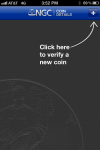
-
Opening screen of the NGC Details app showing where to begin.
-

-
Certificate Entry Screen
-

-
Scanning a barcode, in this case a 2007-D Washington Dollar
-
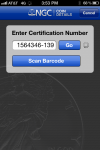
-
The app found the barcode and entered the serial number in the box. Just press the “Go” button
-
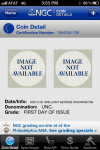
-
The certificate verified and we are presented information about the coin in the slab.
-

-
Specifications of the coin from NGC
-
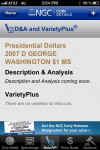
-
Description and Analysis information including Variety Plus information, both missing from the NGC system.
-
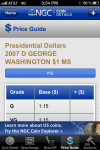
-
Pricing information provided by Numismedia.
-
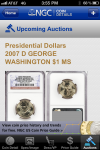
-
It was surprising to see auction information for this coin, but NGC did have some information, which was nice.
-

-
It was difficult to scan older slabs. I wonder if there was a change in barcode formats that the app does not account for?
-
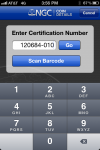
-
Manually entering the certificate number was not that bad except for those of us with not so young eyes would appreciate more flexibility in the scanning process.
-
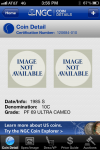
-
The certificate verified.
-
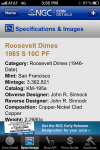
-
Specifications of our proof Roosevelt Dime was pretty much what was expected
-

-
Pricing information was missing from many coins that were manually entered. This is one example.
Jul 9, 2012 | coins, counterfeit, grading, policy
I attended the event sponsored by the Gold and Silver Political Action Committee (GSPAC) on June 27, 2012 to lobby them for passage of the Collectible Coin Protection Act (H.R. 5977) introduced last month by Rep. Fred Upton (R-MI), Chairman of the U.S. House Energy and Commerce Committee, and Lamar Smith (R-TX), Chairman of the U.S. House Judiciary Committee. This is a bill that everyone in the numismatic committee should support and ask their member of congress to support.
For now, I will let the folks at PCGS tell you their experiences at the event (their press release follows). I will follow up at some point with my own thoughts and commentary on the topic. Also, while the press release has one picture, there are three more that I posted to Pinterest that I think are more interesting, including a Morgan Dollar that was cut in half to marry a specific date with a mintmark that was placed in an altered PCGS holder and sent to PCGS for verification. It is fascinating what some people will do and what they get away with.
PCGS Gives Congressmen A Close Look At Counterfeiting Problems
(Washington, DC) – During June 27, 2012 meetings with numismatic leaders in Washington, DC, influential U.S. Congressmen and congressional staff members learned about rare coin authentication and were shown examples of counterfeit coins from the Professional Coin Grading Service (www.PCGS.com) reference collection and examples of counterfeit PCGS encapsulation holders. PCGS has detected over 5,500 counterfeit coins submitted in the last 12 months, a higher number by far than in any previous 12-month period.

PCGS representatives showed Congressmen counterfeit U.S. coins in counterfeit PCGS holders during their recent meetings in Washington, DC. (Photo courtesy of PCGS.)
Vartian met with Rep. Fred Upton (R-Michigan), Chairman of the U.S. House Energy and Commerce Committee, Lloyd Doggett (D-Texas), a member of the House Ways and Means Committee and staff members for other Congressmen including Howard Berman (D-California), the second ranking Democrat on the House Judiciary Committee.
“It was a very successful series of meetings. The Congressmen and staff members focused on the items we brought; actual counterfeit coins and counterfeit holders, and heard about the on-going efforts by PCGS to combat dealers who sell fake coins and holders. We also talked about educating collectors and dealers. But now the numismatic community must come together and urge other members of Congress to support and approve changes to the law.”
Those proposed changes are in HR5977, the Collectible Coin Protection Act of 2012, a bill that would amend and significantly strengthen the Hobby Protection Act of 1973. The Washington meetings were aimed at educating members of Congress about the counterfeiting problems and the need for stronger laws.
“Every collector, every dealer, should personally contact their Congressional representatives now and specifically request they support HR5977,” Vartian emphasized.
“There are several very positive elements in the bill (HR5977) for PCGS and for all collectors and dealers who buy and sell PCGS-certified coins. One provision provides for triple damages for counterfeiting third-party holders such as the patented, sonically-sealed PCGS tamper-evident holders,” said Don Willis, PCGS President.
HR5977 was introduced on June 20 by Congressman Lamar Smith (R-Texas), Chairman of the U.S. House Judiciary Committee, and co-sponsored by Congressman Upton.
The Washington meetings were organized by the Gold & Silver Political Action Committee. In addition to PCGS, representatives of the Industry Council for Tangible Assets (ICTA), the Professional Numismatists Guild (PNG) and Numismatic Guaranty Corporation (NGC) also attended along with former Louisiana Congressman Jimmy Hayes, a long-time collector.
The Hobby Protection Act, first enacted in 1973 and amended in 1988, requires manufacturers and importers of imitation numismatic items to mark them plainly and permanently with the word, “COPY.” The Collectible Coin Protection Act would expand and strengthen the consumer protections to provide remedies against sellers of such items and others who substantially assist them. It also would increase penalties for fake coins fraudulently sold inside counterfeit grading service holders.
Barry Stuppler, Chairman of the Gold & Silver PAC, said if approved by Congress and signed into law by the President the new law would:
- Include not only the distribution but also the sale in commerce of prohibited items;
- Add a provision expanding the Hobby Protection Act to include “any person who provides substantial assistance or support to any manufacturer, importer, or seller” knowingly engaging in any act or practice that violates the Act;
- Expand the venue for legal action to include not just having an agent present, to include “transacts business” — or wherever venue is proper under section 1391 of Title 28, United States Code;” — and
- Add a section on Trademark violations specifically written to include the certification services and adds remedies to the Hobby Protection Act that currently exist under the Trademark Act of 1946 (U.S.C. Title 15, Sections 1116-1118) for violations of the Hobby Protection Act.
In a statement prior to the meetings, Willis stated: “Chinese counterfeiting is the most serious challenge faced not only by the collectibles markets and brand name products, but also by the United States Treasury. Entire industries have sprung up in China to manufacture virtually anything made in America including U.S. Government issued coins. These factories and industries operate in the open and with the full support of the Chinese government. By its lack of action to stop the activities, the Chinese government endorses the counterfeiting of U.S. coins.”
“Even worse, Customs and the U.S. Government do little to stop counterfeits from entering the U.S. Once in the US little effort is made to arrest and prosecute individuals selling counterfeit material. Consequently the U.S. has been flooded with counterfeit products, including coins, resulting in the loss of billions of dollars in revenue each year,&rdquo Willis explained.
 If you are uncomfortable trying to detect whether a coin is counterfeit or not, you might first consider buying from a reputable dealer who has return and/or buy back policies. If you buy raw coins and have questions, ask that the coin be examined by a third-party grading service such as Numismatic Guarantee Corporation, Professional Coin Grading Service, ANACSand Independent Coin Graders. These third-party grading services have a buy-back guarantee so that if the coin is ever found to be counterfeit after it was certified they will buy the coin from you at the price you paid. You may be asked to pay the grading fees. Some dealers may charge a service fee for submitting coins to the grading services on your behalf.
If you are uncomfortable trying to detect whether a coin is counterfeit or not, you might first consider buying from a reputable dealer who has return and/or buy back policies. If you buy raw coins and have questions, ask that the coin be examined by a third-party grading service such as Numismatic Guarantee Corporation, Professional Coin Grading Service, ANACSand Independent Coin Graders. These third-party grading services have a buy-back guarantee so that if the coin is ever found to be counterfeit after it was certified they will buy the coin from you at the price you paid. You may be asked to pay the grading fees. Some dealers may charge a service fee for submitting coins to the grading services on your behalf.





































